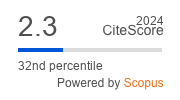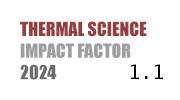THERMAL SCIENCE
International Scientific Journal
TWO-PART QUANTILE REGRESSION ANALYSIS WITH VARIABLE SELECTION FOR COMPLEX DATA AND ITS APPLICATION
ABSTRACT
Semi-continuous data, also known as zero-inflated non-negative continuous data, are commonly observed in various fields such as biomedicine, environmental science, and ecology. Such data exhibit a combination of zero values and positive continuous values that are right-skewed and heteroscedastic. In this study, we present a novel approach for analyzing complex semi-continuous data using a two-part quantile regression method. In addition, we investigate variable selection techniques using least absolute shrinkage and selection operator, smoothly clipped absolute deviation, and minimax concave penalty methods within the framework of two-part quantile regression. Simulation studies are then conducted to evaluate the effectiveness of the proposed methods. Finally, we apply these methods to examine the determinants of health care spending decisions in American households.
KEYWORDS
PAPER SUBMITTED: 2024-03-01
PAPER REVISED: 2024-07-07
PAPER ACCEPTED: 2024-07-07
PUBLISHED ONLINE: 2025-07-06
THERMAL SCIENCE YEAR
2025, VOLUME
29, ISSUE
Issue 3, PAGES [2023 - 2030]
- Han, D., et al., Variable Selection for Random Effects Two-Part Models, Statistical Methods in Medical Research, 28 (2018), 9, pp. 2697-2709
- Chai, H., et al., A Marginalized Two-Part Beta Regression Model for Microbiome Compositional Data. PLOS Computational Biology, 14 (2018), 7, pp. 1-16
- Neelon, B., et al., Zero-Modified Count and Semicontinuous Data in Health Services Research Part 1: Background and Overview, Statistics in Medicine, 35 (2016), 27, pp. 5070-5093
- Neelon, B., et al., Modeling Zero Modified Count and Semicontinuous Data in Health Services Research Part 2: Case Studies, Statistics in Medicine, 35 (2016), 27, pp. 5094-5112
- Liu, L., et al., Statistical Analysis of Zero-Inflated Nonnegative Continuous Data: A Review, Statistical Science, 34 (2019), 2, pp. 253-279
- HCC de Souza., et al., A Bayesian Approach for the Zero-Inflated Cure Model: An Application in A Brazilian Invasive Cervical Cancer Database, Journal of Applied Statistics, 49 (2022), 12, pp. 3178-3194
- Rustand, D., et al., Bayesian Estimation of Two-Part Joint Models for A Longitudinal Semicontinuous Biomarker and A Terminal Event with R-INLA: Interests for Cancer Clinical Trial Evaluation, Biometrical Journal, 65 (2023), 4, pp. 1-22
- Lin, P., et al., Disease Mapping for Spatially Semi-Continuous Data by Estimating Equations with Application to Dengue Control, Statistics in Medicine, 42 (2023), 20, pp. 3636-3648
- Manning, W. G., Basu, A., Estimating Lifetime or Episode-of-Illness Costs under Censoring, Social Science Electronic Publishing, 19 (2020), 9, pp. 1010-1028
- Koenker, R., Quantile Regression, Cambridge University Press, New York, USA, 2000
- Waldmann, E., Quantile Regression: A Short Story on How and Why, Statistical Modeling: Applications in Contemporary Issues, 18 (2018), 3-4, pp. 203-218
- Bernardi, M., et al., Bayesian Quantile Regression using the Skew Exponential Power Distribution, Computational Statistics and Data Analysis, 126 (2018), Oct., pp. 92-111
- Petrella, L., Raponi, V., Joint Estimation of Conditional Quantiles in Multivariate Linear Regression Models with An Application to Financial Distress, Journal of Multivariate Analysis, 173 (2019), Sept., pp. 70-84
- Reich, B. J., et al., Bayesian Spatial Quantile Regression. Journal of the American Statistical Association, 106 (2011), 493, pp. 6-20
- Tibshirani, R., Regression Shrinkage and Selection via the Lasso, Journal of the Royal Statistical Society, Series B, 58 (1996), 1, pp. 267-288
- Zhang, C. H., Nearly Unbiased Variable Selection under Minimax Concave Penalty, Annals of Statistics, 38 (2010), 2, pp. 894-942
- Chowdhury, S., et al., Group Regularization for Zero-Inflated Poisson Regression Models with An Application to Insurance Ratemaking, Journal of Applied Statistics, 46 (2018), 9, pp. 1567-1581
- Simon, N., et al., Regularization Paths for Cox's Proportional Hazards Model via Coordinate Descent, Journal of Statistical Software, 39 (2011), 5, pp. 1-13
- Wang, L., et al., Quantile Regression for Analyzing Heterogeneity in Ultra-High Dimension, Journal of the American Statistical Association, 107 (2012), 497, pp. 214-222
- Maruotti, A., et al., A Two-Part Finite Mixture Quantile Regression Model for Semi-Continuous Longitudinal Data, Statistical Modelling, 22 (2020), 6, pp. 485-908

